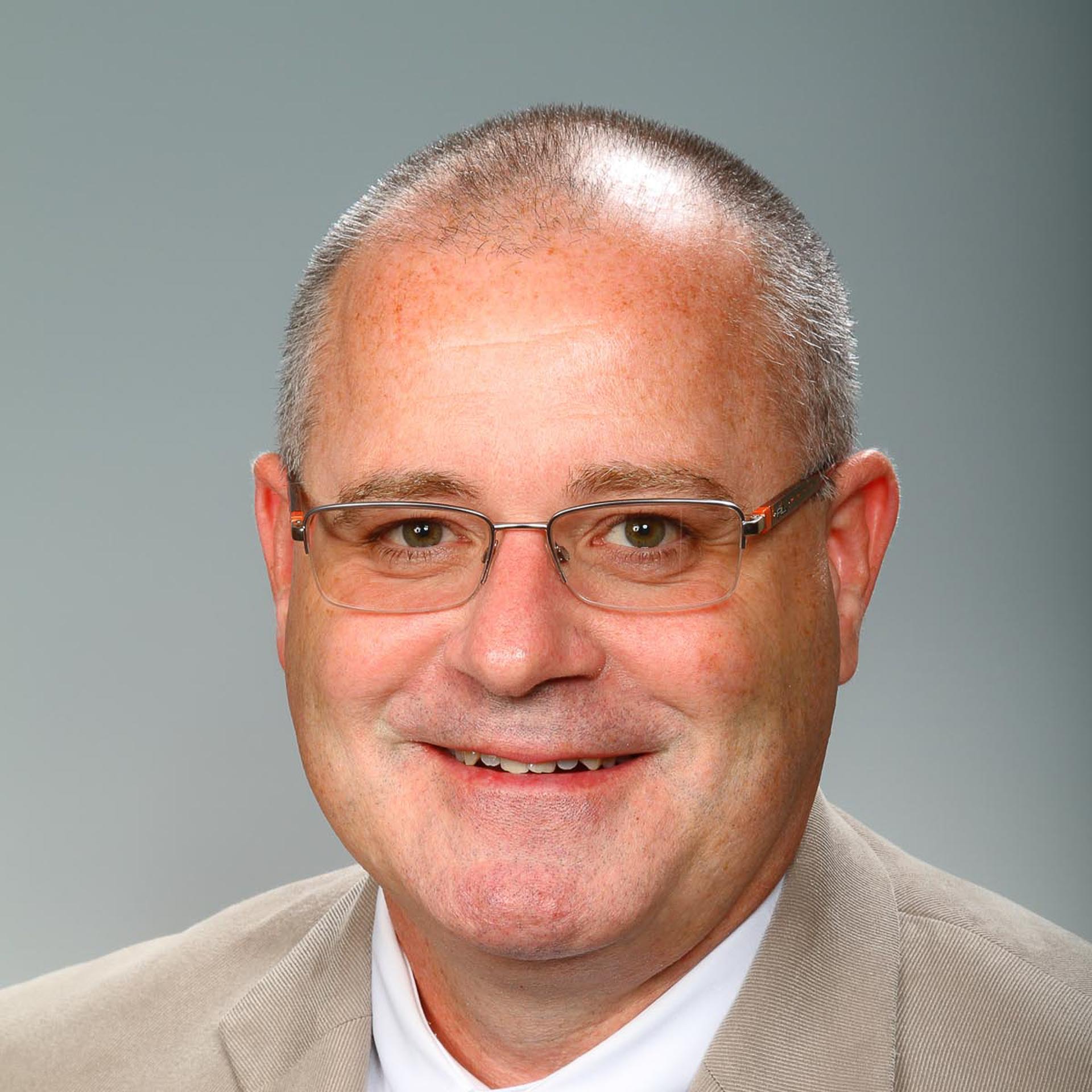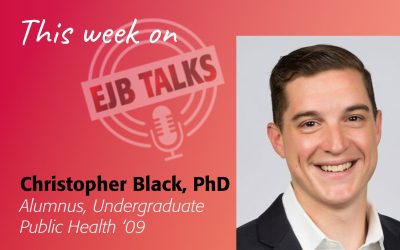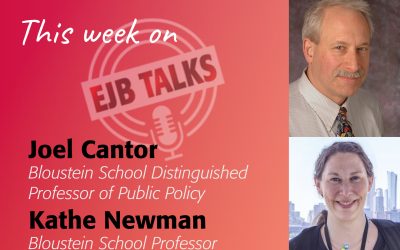Jon Carnegie, Executive Director of the Alan M. Voorhees Transportation Center (VTC) at the Bloustein School, joins Stuart Shapiro on EJB Talks this week. VTC is a leader in transportation planning and policy research and education at the national, regional, and state levels. Jon talks about VTC’s core strengths related to transportation in the built environment and its work in transit-oriented development, pedestrian and bicycle mobility and safety, healthy community design, smart growth, and transportation and social equity. They discuss the relationship between transportation, social justice, and the environment. He tells Stuart about some of their exciting outreach and research including the New Jersey Travel Independence Program (NJTIP@Rutgers), VTC’s partnership with the New Jersey Climate Change Alliance which is centered around decarbonizing the transportation sector, and the center’s cross-disciplinary work with the Rutgers Schools of Engineering (SOE) and Environmental and Biological Sciences (SEBS) for the New Jersey Department of Transportation, just to name a few. Tune in for all the details!
Stuart Shapiro
Welcome to EJB Talks. I’m Stuart Shapiro, the Interim Dean of the Bloustein School, and the purpose of this podcast is to highlight the work my colleagues, and our alumni in the fields of policy, planning, and health are doing to make the world the country and New Jersey a better place.
This season we’re featuring representatives of our amazing research centers. People that have not really been on the podcast much to date. And today, my guest is Jon Carnegie from the Voorhees Transportation Center. Welcome, Jon.
Jon Carnegie
Hey, Stuart, thanks so much for having me here.
Stuart Shapiro
Great. We’re glad to have you. Can you start by telling us about the mission of the Voorhees Center and your role there?
Jon Carnegie
I sure can. So, the Voorhees Transportation Center, which I probably will refer to more than once as VTC, was established here at the Bloustein School in 1998, to honor the significant contributions made by Alan M Voorhees to the field of transportation planning and engineering. Alan Voorhees was one of the nation’s pivotal figures in city planning and transportation throughout the 1960s 70s and into the 80s. And over the past 24 years, almost 25 years now, the center has grown to be a leader in transportation planning, and policy research and education at the national, regional, and state levels.
We address a broad array of transportation and mobility topics, including emerging topics like transportation, shared mobility, micro-mobility, automated vehicles, connected vehicles, big data in transportation. And then we have really long-standing core strengths related to transportation in the built environment. So things like transit-oriented development, pedestrian and bicycle mobility, safety, healthy community design, smart growth, things like that. Transportation and social equity, which for us most often means looking at the transportation needs and addressing the transportation needs of disadvantaged populations, as well as environmental justice. Transportation in the environment, transportation, finance, and the economy.
And, the center has a staff of about 30, full-time researchers, administrative staff, and affiliated faculty. I serve as the center’s Executive Director, which means I kind of run the day-to-day operations of the center, including managing staff and overseeing budgets, working with Bob Noland, our Faculty Director to set the strategic direction of the center. I also maintain a portfolio of my own research and planning projects, and I sometimes teach for the Bloustein School as an adjunct member of the faculty.
Stuart Shapiro
Wonderful, we could probably spend a podcast on any of about 10 things you just mentioned. So I’m going to pick out a couple. We have focused on the podcast a lot on social justice and equity, and you did mention that, and when social equity and justice come to mind, you know, we think about health, we think about welfare programs. A lot of people don’t think about transportation right away. And I was wondering if you could elaborate on the connection between the issues you study and social justice.
Jon Carnegie
Sure, great question. Equity is really an important consideration in many of the projects that we do. I think you know when you think about leading a healthy, prosperous life, transportation, mobility, access to the destinations that are important to living our lives, is really critical. And whether you’re walking or biking or taking public transportation or driving your own vehicle. Transportation connects us to jobs, to essential services, to recreation to leisure activities, and connects us to our friends and family. You know, for most of us, especially, if we own a car, transportation ends up being kind of the background noise in daily life, right? So most of us don’t even give it too much thought and in your introduction to this question, you pointed that out.
I think however if you don’t have access to a car, and you cannot drive for some reason, maybe you have a disability or you can’t afford to own a car or whatever, then decisions about how you’re going to get from where you are to where you need to go become super important. Unfortunately, for too many people choices are limited. So much of the research, training, and technical assistance work that we do here at the Voorhees Transportation Center focuses on equity from the point of view of expanding travel options that are affordable, convenient, and safe for everyone. Many of our projects in some way relate to ensuring that all People have fair and just access to transportation resources and that the travel options that people have are safe, convenient, and affordable. So that all transportation, hopefully someday becomes the background noise in everybody’s life.
Stuart Shapiro
Yeah, it is amazing how much those of us with cars take for granted. You know, it comes up often in public policy contexts, or, you know, what’s the big deal? They have to you to go get an ID for voting, for example, or they have to go to the welfare office to get their check. Well, it is a big deal if you don’t have a car.
Jon Carnegie
That’s right, it’s often much easier said than done for many aspects of getting where we need to go.
Stuart Shapiro
So can you talk about one project in particular, in this arena that you’d like to highlight?
Jon Carnegie
Oh, my goodness, one project. You know, I think what always comes to mind, a great example of work that we do at the center is VTCs New Jersey Travel Independence Program. Probably one of the few examples within the Bloustein School of a direct service project that we have, multiple projects. But, NJTIP at Rutgers… I think you might have actually spoken to Karen Alexander, maybe?
Stuart Shapiro
We did! I was going to mention Karen.
Jon Carnegie
Yeah so, that project, that unit of the Voorhees Transportation Center works with a variety of partner organizations and agencies to broaden access to public transportation information and to train people with disabilities and older adults, in particular, how they can use the public transit services in New Jersey so that they feel more empowered to lead more independent and well-connected lives. So that’s one example of a suite of projects that we do.
Another example is a project that we’re doing in partnership with the New Jersey Climate Change Alliance. And that project, we named the Healthy, Just, Resilient, and Carbon Neutral Mobility Project… It kind of rolls off the tongue, or not…
Stuart Shapiro
It doesn’t even make a good acronym for it. ((Laughing))
Jon Carnegie
Actually, if you change them around it, it actually spells out SHARE which… ((laughing))
Anyway, the project was centered around decarbonizing the transport sector, which you can imagine, being a project we’re doing with the Climate Change Alliance. But we’re pursuing the goal of decarbonizing the transportation sector in a way that advances other important community planning goals, our underlying kind of concept is that if we make it easier and safer, to walk, and bike, and more convenient to take public transportation and other shared modes of travel, then we’ll empower people to drive less, which will ultimately reduce greenhouse gas emissions and make access to transportation more equitable.
And, I think of this project in response to your question about equity examples, because that’s a really central component of the project, which is… one of the objectives is to make sure that our efforts to decarbonize transportation in New Jersey really is equitable, and just not just by providing rebates and incentives to encourage people to buy electric vehicles, but other important aspects of transportation as well, because the vast majority of subsidies, which you may or may not know, go to higher-income residents. So we want to make sure that we’re paying attention to the mobility needs of and the climate needs of lower-income populations, minority populations, etc. I have a bunch of other examples that I could give you. But, those are just a couple.
Stuart Shapiro
That’s fantastic. It’s also a great segue, I wanted to talk about the environment for a couple of minutes here. Unlike social justice and equity, transportation in the environment, I think most people understand that there’s a connection, right? Maybe more than any other sector except for possibly the power, electricity sector. Transportation has a big impact on the environment. Can you talk a little bit about that impact, particularly climate change, which you’ve already alluded to?
Jon Carnegie
Sure. As I mentioned before, this is one of the core areas of research that the center is somewhat specialized in overtime. And the research we’ve done has been mostly related to transportation’s role in energy consumption, air pollution, more recently, climate change aspects, and also something called green infrastructure solutions, which are what kind of nature-based solutions is to mitigate some of the negative effects of transportation on the environment. We also do research in the area of transportation resilience, which is related to climate change, obviously, but a little bit different. We’ve already discussed the ways in which we all make choices every day on how to get around. And those individual choices that we make every day can have either positive or negative impacts on the environment.
Driving alone in a private automobile is very energy consumptive and polluting. In fact, in New Jersey, more than 40% of New Jersey’s greenhouse gas emissions come from the transportation sector, and the vast majority of those are derived from private vehicle use. So every time we decide to drive instead of walking or biking or taking public transit, we generate more emissions. Another aspect of transportation-related to the environment that we don’t always think of, but we should, are the roads and parking the kind of infrastructure needed to support our auto-oriented lives results in water pollution from stormwater runoff. Roads and parking the pavement contribute to increases in ambient air temperatures, which cause a heat island effect, especially in urban areas, and very often in lower-income and minority communities. So our projects have touched on and sought to advance solutions that help to address those negative impacts as they relate to transportation in the environment.
Stuart Shapiro
Fascinating. I learned a lot, just in those two minutes there. I also try to walk to work every day. Although I have to admit the last couple of weeks as it’s been really cold out, I have given in and driven a few times. I’m fascinated by this green transportation infrastructure you mentioned, can you talk a little bit about some examples of that?
Jon Carnegie
Yeah, sure. Let’s see. I think the things that we think about most often are street trees and things like that have the ability to sequester carbon when planted along streets. They actually clean the air, dust and particles and particulate matter and things of that as well. But other types of green infrastructure, are rain gardens, or bioswales, the things that we can do that are more nature-oriented in terms of dealing with stormwater runoff. And, most of our transportation infrastructure for decades or even a century, has relied a lot on pipes, culverts, and gray infrastructure that go along with the roads and the parking lots and things like that. But there are lots of ways where we can incorporate nature-based solutions to do these things. So even impervious pavement or brick pavement interspersed with grass for overflow parking, all of those things have a positive impact on the heat on stormwater runoff on sequestering carbon and can help to kind of balance out some of the greenhouse gas and other pollution that happens when we drive around a lot.
Stuart Shapiro
And are states and municipalities open to these ideas, as they rebuild their infrastructure?
Jon Carnegie
You know, I think they are increasingly embracing these. A lot of it is learning how to use those. So first off, to think about them when we’re designing our projects and maintaining our infrastructure. But the other is sort of learning and experiencing them so that we have the appropriate maintenance protocols in place and things like that. Because I do often require different approaches to maintenance and operations and things like that.
So the one thing that we try to do is to share leading practices and experience of peer type organizations, so when working with municipalities, we show examples of what other municipalities have done in that regard, state DOT kind of similar approach. We look for ways in which we can adjust our policies and our procedures and things like that to accommodate these types of solutions. And I think probably, you know, we may be at a unique juncture in the policy and political environment to support this kind of thing. Because of the infrastructure bill and the confluence of the desire of both the administration in place in Washington and in New Jersey to address multiple issues at once. So to address climate change to address environmental justice, and to invest in our infrastructure. So I think there may be dollars out there and programs that provide incentives to do more of the green streets type of work that I just described.
Stuart Shapiro
Now, that’s helpful. I’ll let you end by picking one more project in any area that you guys are working on that you want to tell people about?
Jon Carnegie
Yeah, I think I might stick with this climate nature, resilience kind of theme. And tell you a little bit about a project that I’m working on, I’ve had the great fortune of working on over the last year and a half or so in partnership with our colleagues at the School of Engineering in the School of Environmental and Biological Sciences. It’s a project that we’re doing for the New Jersey Department of Transportation. We’ve created a visualization tool, a GIS-based visualization tool that will be available to all of NJ DOT engineers and planners to help them understand the potential exposure of New Jersey’s transportation infrastructure to climate risks, in particular flooding and sea-level rise, but also increased precipitation and temperature. And we’ve been working with them over the last year to kind of incorporate the use of this tool in the workflows of each of their different offices and project development process so that hopefully, our transportation infrastructure can become more resilient over time.
It’s a really interesting project too because we’ve created for the first time, a layer, a data layer for not just the Department of Transportation, but for community planners as well, that will be released a little later this year, that looks at the impact of future increases in precipitation on streamflow and flooding outside of the coastal area. And it’ll be for the first time kind of a climate adjusted, look at potential flooding in areas that are not along the coast.
So it’s really exciting to be involved in the project and to work with the incredibly smart researchers at the School of Engineering and Environmental and Biological Sciences to kind of pair that with the policy and of the work that we brought to the project. So it’s been personally and professionally rewarding because I’m seeing it being used already to affect the future of transportation infrastructure.
Stuart Shapiro
That’s great. I’ve learned a lot. Thank you so much for coming on, Jon.
Jon Carnegie
It was a pleasure to be here. Thanks so much for having me.
Stuart Shapiro
Also, a big thank you to Amy Cobb and Karyn Olsen, our production team. We’ll see you next week with another talk from another expert at the Bloustein School. Until then, stay safe.




